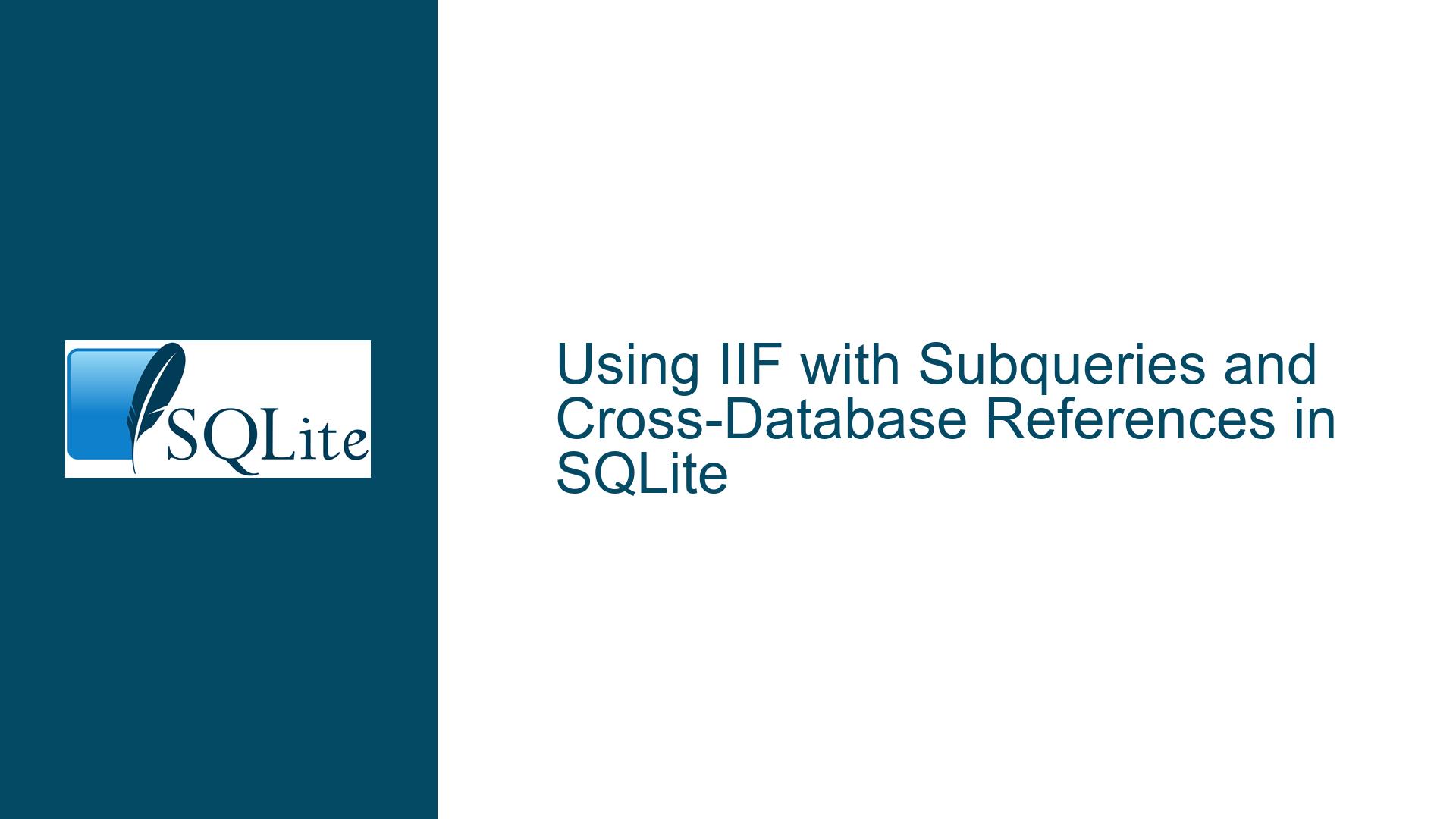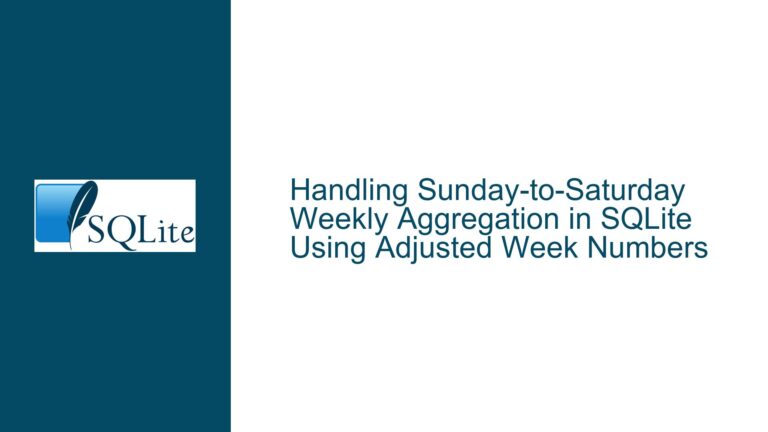Using IIF with Subqueries and Cross-Database References in SQLite
Issue Overview: Syntax Errors and Column Reference Problems in IIF with Subqueries
The core issue revolves around the use of the IIF function in SQLite, specifically when attempting to incorporate a subquery within it. The user initially encountered a syntax error when trying to use a SELECT statement directly inside the IIF function. After resolving the syntax error by adding parentheses around the subquery, a new issue emerged: the no such column error, which indicates that SQLite cannot locate the specified column in the context of the query. This problem is further complicated by the fact that the query involves two separate databases, with the users table residing in an attached database (second.db) and the Buying table in the primary database.
The user’s goal is to conditionally select data from the Buying table based on the id column in the users table, using the IIF function to return a default value ('nada') when the condition is not met. However, the query fails to recognize the second.users.id column, even though a simple SELECT * FROM second.users query returns the expected results. This suggests that the issue is not with the database attachment or the existence of the column but rather with how SQLite interprets column references within the IIF function when combined with subqueries and cross-database references.
Possible Causes: Misinterpretation of Column References and Database Context
The no such column error in SQLite typically occurs when the database engine cannot resolve a column reference within the given context. In this case, several factors could be contributing to the problem:
Ambiguity in Column References: When using attached databases, SQLite requires explicit qualification of table names with their respective database names (e.g.,
second.users.id). However, theIIFfunction may not be correctly interpreting the qualified column reference, especially when combined with a subquery. This could be due to a parsing issue or a limitation in how SQLite handles nested expressions.Database Attachment Issues: While the user confirmed that
SELECT * FROM second.usersworks, it is possible that the attachment process is not fully propagating the schema information required for complex queries. For example, if the attachment is not properly established or if there are conflicts between schemas, SQLite might fail to resolve column references correctly.Version-Specific Behavior: SQLite’s behavior can vary between versions, particularly when dealing with advanced features like subqueries and conditional functions. The user’s environment might be running an older version of SQLite that does not fully support the intended usage of
IIFwith subqueries and cross-database references.Query Parsing Limitations: SQLite’s query parser might struggle with the combination of
IIF, subqueries, and cross-database references due to the complexity of the expression. The parser might misinterpret the qualified column name (second.users.id) as a standalone identifier rather than a reference to a column in an attached database.Schema Differences: If the
usersandBuyingtables have different schemas or if there are discrepancies in how theidcolumn is defined (e.g., data type mismatches), SQLite might fail to resolve the column reference correctly. This could be exacerbated by the use of attached databases, where schema information needs to be synchronized across multiple contexts.
Troubleshooting Steps, Solutions & Fixes: Resolving Column Reference and Syntax Issues
To address the issues described above, follow these detailed troubleshooting steps and solutions:
1. Verify Database Attachment and Schema Consistency
Before diving into complex queries, ensure that the database attachment process is working as expected and that the schemas of the users and Buying tables are consistent. Run the following queries to confirm:
-- Attach the second database
ATTACH DATABASE "second.db" AS second;
-- Verify that the users table exists in the second database
SELECT * FROM second.users;
-- Verify that the Buying table exists in the primary database
SELECT * FROM Buying;
If either query fails, double-check the file paths and ensure that the databases are correctly attached. Additionally, confirm that the id columns in both tables have compatible data types (e.g., both are integers).
2. Simplify the Query to Isolate the Issue
To isolate the issue, simplify the query by removing the IIF function and the subquery. Start with a basic query that references the second.users.id column:
SELECT second.users.id FROM second.users;
If this query fails with a no such column error, the problem lies in how SQLite is interpreting the qualified column name. In this case, try dropping the second. qualifier:
SELECT id FROM second.users;
If this works, it suggests that SQLite is having trouble with the qualified column name. This could be due to a parsing issue or a limitation in the SQLite version being used.
3. Use Explicit Aliases for Clarity
To improve readability and reduce ambiguity, use explicit aliases for tables and columns. For example:
SELECT u.id, u.user
FROM second.users AS u;
This approach makes it clear which table each column belongs to and can help SQLite resolve column references more accurately.
4. Rewrite the Query Using a JOIN
As suggested by Phil G in the discussion, rewriting the query using a JOIN instead of a subquery can often resolve issues with complex expressions. Here’s how you can rewrite the query:
SELECT u.id, u.user,
IIF(u.id > 1, b.number, 'nada') AS number
FROM second.users AS u
LEFT JOIN Buying AS b ON u.id = b.id;
This approach eliminates the need for a subquery and makes the query easier to read and debug. The LEFT JOIN ensures that all rows from the users table are included, even if there is no matching row in the Buying table.
5. Check SQLite Version and Upgrade if Necessary
SQLite’s behavior can vary between versions, particularly when dealing with advanced features. To check the version of SQLite being used, run the following query:
SELECT sqlite_version();
If the version is older than 3.43.2 (the version mentioned in the discussion), consider upgrading to a newer version. Newer versions of SQLite often include bug fixes and improvements that can resolve issues with complex queries.
6. Use CASE Instead of IIF for Better Compatibility
If the IIF function continues to cause issues, consider using the CASE statement instead. The CASE statement is more widely supported and can handle complex conditions more gracefully. Here’s how you can rewrite the query using CASE:
SELECT u.id, u.user,
CASE
WHEN u.id > 1 THEN (SELECT number FROM Buying WHERE Buying.id = u.id)
ELSE 'nada'
END AS number
FROM second.users AS u;
This approach provides greater flexibility and can help avoid issues with parsing and column references.
7. Debug with Intermediate Queries
To further debug the issue, break the query into smaller parts and test each part individually. For example:
-- Test the subquery
SELECT number FROM Buying WHERE Buying.id = 2;
-- Test the IIF function with a static value
SELECT IIF(2 > 1, 'yes', 'nada');
-- Combine the subquery and IIF function
SELECT IIF(2 > 1, (SELECT number FROM Buying WHERE Buying.id = 2), 'nada');
By testing each component separately, you can identify which part of the query is causing the issue and focus your troubleshooting efforts accordingly.
8. Ensure Proper Indexing for Performance
If the query involves large datasets, ensure that the id columns in both tables are properly indexed. Indexing can significantly improve query performance and help SQLite resolve column references more efficiently. Here’s how you can create indexes:
CREATE INDEX idx_users_id ON second.users(id);
CREATE INDEX idx_buying_id ON Buying(id);
9. Test in a Controlled Environment
To rule out environment-specific issues, test the query in a controlled environment, such as the SQLite command-line interface (CLI) or a different Python script. This can help identify whether the issue is related to the specific environment or configuration being used.
10. Consult SQLite Documentation and Community
If the issue persists, consult the official SQLite documentation and community forums for additional insights. The SQLite documentation provides detailed information on query syntax, functions, and best practices, while the community forums can offer practical advice and solutions from experienced users.
By following these troubleshooting steps and solutions, you should be able to resolve the issues with using IIF and subqueries in SQLite, particularly when dealing with cross-database references. The key is to simplify the query, verify the database attachment and schema consistency, and use alternative approaches like JOIN or CASE if necessary. Additionally, ensuring that you are using a recent version of SQLite and properly indexing your tables can help avoid similar issues in the future.






